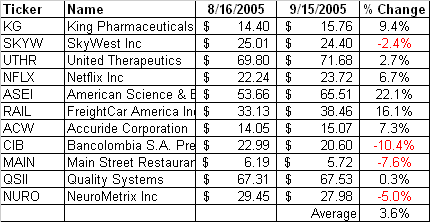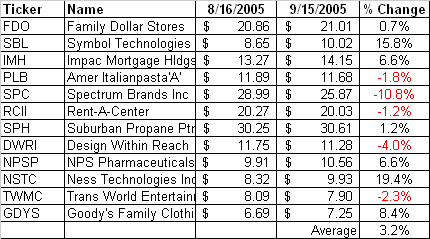A couple of days ago, I came across an article that discussed the realities of buying stocks that were hitting new 52-week highs. I don't remember where the article was, but I knew immediately it would be worth a closer look in my column.
The basic philosophy of the strategy is simply this - stocks that are strong enough to reach new highs are usually apt to keep moving in that direction. So, if you were to buy a stock hitting a new high, odds are that you'd be reapng some profits within a short period of time. In other words, you should 'buy into strength'. The idea has worked its way into the investing community over the years, so much so that now it's common knowledge to even the most casual trader. However, the strategy has come under fire in recent years. With the onset of a highly volatile market (largely in thanks to the internet), a lot of traders are grumbling that buying into strength is actually backfiring. Instead, these folks argue that the stratgey backfires, and that you should be selling into strength.
Quite frankly, I understand both points of view. However, I'm much more interested in facts. So to put the theory to the test, we're going to go back in time and play 'what if'. All we need to do is go back and find the stocks that were hitting new 52-week highs a month ago, and see of those same stocks are higher now. However, in the interest of fair play, we have to do the same for the weak stocks. From that same day, we're going to find stocks that were hitting new 52-week lows, and we'll switch the philosophies to 'short into weakness' and buy into weakness'. After all, we have to be realistic about the effects that the overall market can have on an individual stock......even the best and worst ones.
The stocks that were hitting new 52-week highs on August 16th appear in the table below. We removed penny stocks, stocks under $5, and low volume stocks from the results, since those might paint an unrealistic picture of the market that you and I have to work with as traders. The closing price from that day appears on the table too, as does the current price. The tale is told, though, by the percentage gain column. These stocks should be higher according to the traditional strategy, but does that idea still hold water this time? Take a look.
Stocks Hitting New Highs on August 16th, 2005

Actually, the idea did work in this case - these stocks are all higher. However, most of them have been headed lower the last two weeks, giving up the even bigger gains achieved after we built this list. But still, we have to respect these results. On the other hand, what would have happened if we shorted the stocks hitting new lows on that same day? Would we get similar results, better, or worse? Take a look, and remember, for these short trades to be profitable, you'd want to see the stocks lose value.
Stocks Hitting New Lows on August 16th, 2005

The theory didn't work quite as well in reverse. Actually, it didn't work at all - you would have lost money by shorting into weakness. In fact, you would have done almost as well buying (long) the stocks that were hitting new lows that day as you would have by buying the new highs.
Conclusion? Based on this study alone, there's really not much advantage in looking to buy into strength. Certainly there's a little, but that 0.4% differential could be attributable to sampling error. I'll suggest that the real litmus test is actaully comparing these results to what the market did during the same period. And what was that? Between August 16th and yesterday, the Russell 2000 is up by 1.6%. The S&P 500 is up 0.6%. From that perspective, there may be some merit to looking for stocks hitting new highs.....as well as finding stocks hitting new lows. In other words, these stocks (both lists) are a great place to start looking for ideas, because these stocks are on the verge of going parabolic, or staging a huge recovery. Or on the bearish side, these stocks are the most vulnerable to a major meltdown. However, new highs and new lows by themselves are not enough reason to buy or short a stock.
One last thing - although the research here was only partially conclusive, I'll add that a great deal of the gains (or losses) that these stocks may make is largely dependent on what the overall market is doing. For that reason, it's immensely important to get the market right first. Had the major indexes been down during this period, I suspect that the returns you see above probably would have been negative...even for the stocks hitting new highs a month ago. But that's another column
Price Headley is the founder and chief analyst of BigTrends.com.